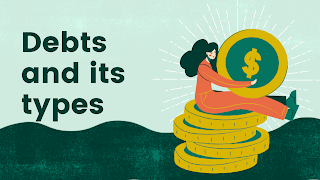How to learn personal finance? Personal finance in India is a vast and dynamic field, with its own unique set of challenges and opportunities. Here's a breakdown to get you started: Challenges: Low financial literacy: Many people lack basic knowledge about managing money, making them susceptible to scams and poor financial decisions. Income inequality: The gap between the rich and the poor is significant, making it harder for many to achieve financial security. Inflation: Rising prices can erode savings and make it difficult to plan for the future. Formal vs. informal sector: A large part of the workforce is employed in the informal sector, which often lacks access to financial products and services. Opportunities: Growing middle class : The Indian middle class is expanding rapidly, creating a larger market for financial products and services. Government initiatives: The government is taking steps to improve financial literacy and access to financial service...
Debt: What It Is, How It Works, Types, and Ways to Pay Back & Corporate Debt
Debt can be a complex topic, but understanding the different types can help you manage it effectively. Here's a breakdown of the main categories:
By Collateral:
- Secured debt: This type of debt is backed by collateral, such as your house for a mortgage or your car for a car loan. If you default on the loan, the lender can seize the collateral. Secured loans typically have lower interest rates than unsecured loans.
- Unsecured debt: This type of debt has no collateral. Examples include credit card debt, personal loans, and medical bills. If you default, the lender has no claim on your assets, but they can take other measures to collect, such as damaging your credit score. Unsecured loans often have higher interest rates than secured loans.
By Repayment:
- Revolving debt: This type of debt has a credit limit that you can borrow from and repay over time. Examples include credit cards and lines of credit. You can make minimum payments, but interest accrues on the remaining balance.
- Installment debt: This type of debt has a fixed loan amount and repayment schedule. Examples include mortgages, car loans, and student loans. You make fixed monthly payments until the loan is paid off.
By Purpose:
- Consumer debt: This type of debt is used for personal expenses, such as housing, transportation, and education.
- Business debt: This type of debt is used to finance business operations, such as equipment, inventory, and marketing.
Other types of debt:
- Government debt: This is money owed by a government to its creditors, such as banks and investors.
- Medical debt: This is debt incurred for medical expenses, such as hospital bills and doctor's visits.
Additional factors to consider:
- Interest rates: The interest rate is the cost of borrowing money. Lower interest rates are generally better.
- Loan terms: The loan term is the length of time you have to repay the loan. Longer loan terms can mean lower monthly payments, but you will pay more interest overall.
- Fees: Some loans have fees, such as origination fees and late payment fees. Be sure to factor in these fees when comparing loans.
Understanding the different types of debt can help you make informed decisions about borrowing money and managing your finances. If you're struggling with debt, there are resources available to help you get back on track. You can talk to a financial advisor or credit counselor for personalized advice.
Do you have any specific questions about debt that I can help you with?

Comments
Post a Comment